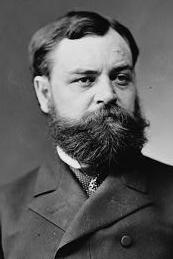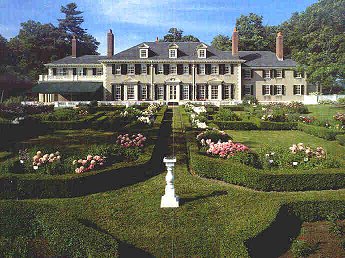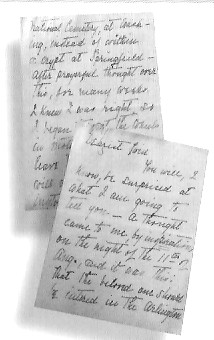Robert Lincoln |
|
|
|
Robert at age 17, in mid-life, and in his upper 70's (Ostendorf Collection Photographs)
|
|
Robert Todd Lincoln, Abraham and Mary's first child, was born August 1, 1843. Robert, who was named for his mother's father, was born in downtown Springfield, Illinois, in the Globe Tavern (pictured to the right; Illinois State Historical Library photograph) where the Lincolns lived after their marriage in 1842. The Globe Tavern was an unsuitable place for a couple with a baby, and the Lincolns moved in the fall to a frame cottage at 214 S. Fourth Street. In 1844 the couple purchased a home from Dr. Charles Dresser, the Episcopal minister who had married them. This would prove to be the only home the couple ever owned.
As a child in Springfield, Robert attended subscription-based Springfield Academy from 1850 to 1853. Springfield Academy was operated by a man named Abel Wilder Estabrook (not Esterbrook; the correct spelling was noted by Dr. Wayne C. Temple on p. 42 of the Spring 2000 edition of the Lincoln Herald). Springfield Academy was located on the west side of Fifth Street, between Monroe and Market (Capitol) Streets.
In 1853, Robert enrolled in the Illinois State University in Springfield which was a preparatory school with four instructors. Apparently, the studies weren't difficult. In Robert's own words, "We did just what pleased us, study consuming only a very small portion of our time." In 1859 Robert applied to Harvard, but he failed its entrance examinations. It was apparent his education in Springfield was quite deficient.
|
|
|
To better prepare himself for Harvard, Robert enrolled at Philips Exeter Academy in Exeter, New Hampshire, on September 15, 1859. The Academy at Exeter was a famous preparatory school. His father visited him during the early part of 1860. After his year at Exeter, Robert was accepted at Harvard and became a member of the Class of 1864.
Robert spent the next four years at Harvard. He saw his family on vacations. Harvard was a much smaller school in the 1860's than it is now. Of the 99 graduates in July of 1864, Robert ranked 32nd. After graduation, he enrolled at Harvard Law School.
Robert spent only a short period of time at the Harvard Law School. It isn't exactly clear why he left. By the end of the year, he was living at the White House. Early in 1865 (after his father had written a letter to Ulysses S. Grant) Robert joined General Grant's staff as a captain. Captain Lincoln's main duty as an army officer was that of escorting visitors to various locations. Additionally, he was present at Appomattox when Robert E. Lee surrendered to Grant.
On the morning of the day his father was assassinated, Robert was back in Washington and had breakfast with his family. Robert discussed the war with the president. That evening Robert was in his room at the White House when news that his father had been shot reached him. He departed immediately and spent the night at his father's bedside and comforting his mother. The end came at 7:22 A.M. on April 15, 1865. Robert spent most of the next several weeks at the White House attempting to console Mary and his younger brother, Tad.
In May of 1865 the Lincolns boarded a train for Chicago. Robert would be a Chicago resident for the next 46 years. Robert lived with his mother until the spring of 1867. He took courses at the University of Chicago and was admitted to the bar on February 25, 1867. He was now a full-fledged lawyer.
|
|
In 1868 Robert married Mary Eunice Harlan (pictured to the left; Iowa Wesleyan College photograph). The marriage produced three children (pictured to the right; Chicago History Museum photograph): Mary (born on October 15, 1869), Abraham who was nicknamed "Jack" (born on August 14, 1873), and Jessie (born on November 6, 1875). Mary Lincoln, who lived until 1938, married Charles Isham, son of Robert's law partner. They had one son, Lincoln Isham, who was born on June 8, 1892, and passed away September 1, 1971. Lincoln Isham married Leah Alma Correa in 1919, but the couple had no children. Abraham "Jack" Lincoln II died in 1890 while the family was in England during Robert's tenure as our minister there. Jessie Harlan Lincoln, who lived until 1948, married Warren Beckwith in 1897, and they had two children, Mary "Peggy" Beckwith (1898-1975) and Robert Todd Lincoln Beckwith (1904-1985), both of whom never had any children. Robert's wife, Mary, was shy and often sickly. |
|
|
By 1875 Robert had become extremely concerned with his mother's mental state. He instigated an insanity hearing which led to her being committed to a sanitarium for a short time. Robert testified against his mother at the trial. Mary despised Robert's actions and accused him being after her money. For more information on Mary's insanity trial, please CLICK HERE.
During the 1870's Robert became an established and successful lawyer. In 1877 he turned down President Rutherford B. Hayes' offer to appoint him assistant secretary of state. In 1881 he accepted President James Garfield's appointment as secretary of war. He served in that role until 1885. In 1889 President Benjamin Harrison appointed him minister to England, and he spent the next four years in that position. Robert's name was discussed as a potential Republican presidential candidate in 1884, 1888, 1892, and 1912, but Robert never sought the position.
After George Pullman's death in 1897 Robert became acting president of the Pullman Company. He became the permanent president in 1901. He served in this capacity until 1911 when he resigned as president and was named chairman of the board. He continued in that position until January 14, 1922.
|
|
In 1902 Robert purchased several hundred acres of land in Manchester, Vermont. On this property he built a country mansion called Hildene for use as a summer home. (The photograph of Hildene comes from a pamphlet published by the Friends of Hildene, Inc., a Vermont not-for-profit corporation.) The estate included gardens, lawns, and woodlands. When staying at Hildene Robert especially enjoyed golf and amateur astronomy. In 1911 Robert sold his home in Chicago and bought a magnificent three story colonial brick mansion in Washington, D.C. From this time on it was Robert's custom to go to Hildene in the spring and return to Washington in the fall. The Lincolns made the trip back and forth in their private Pullman car called Advance. Hildene remained in the Lincoln family until the 1970's. For more information on Hildene, CLICK HERE. |
|
Robert made his last major public appearance on May 30, 1922. The occasion was the dedication of the Lincoln Memorial. President Warren G. Harding and Chief Justice William Howard Taft spoke during the ceremonies. (Robert is pictured with Taft and Harding in the Library of Congress photo to the right.) The memorial certainly pleased Robert. He was always very proud of the various honors paid to his famous father. |
|
|
On May 11, 1926, the Lincolns continued their normal routine of traveling from Washington to Hildene for the summer. On Sunday, July 25, 1926, Robert went to bed as usual, but when the butler entered the bedroom the next morning he found that Robert had passed away during the night. According to Robert's physician, he had suffered a "cerebral hemorrhage induced by arteriosclerosis." Robert was 82. Private funeral services were held at Hildene. Robert was not buried in the Lincoln Tomb in Springfield. His remains were temporarily buried in a plot in Manchester, but his final internment occurred on March 14, 1928, at Arlington National Cemetery. Robert's widow, Mary Harlan Lincoln, lived until March 31, 1937, and she was also buried in Arlington.
After many years of mystery, the reasons why Robert was buried in Arlington rather than the Lincoln Tomb were revealed in an excellent article in the Summer 1998 edition of Lincoln Lore. Using a previously unknown letter held in a private collection as their source, authors Gerald D. Swick and Donna D. McCreary reveal that it was Mary Harlan Lincoln's sole decision to have Robert interred at Arlington. In a letter to Katherine Helm, Robert's cousin, Mary revealed that she felt Robert "was a personage, made his own history, independently (underlined 5 times) of his great father, and should have his own place 'in the sun'!" In the words of Swick and McCreary, Mary therefore made the decision "to give her husband the honor she felt he deserved." If you are interested in viewing Robert's grave at Arlington, CLICK HERE.
|
|
|
Mary Harlan Lincoln's Letter to Katherine Helm
To the left is an image of the letter Mary Harlan Lincoln wrote to Katherine Helm about Robert Lincoln's burial. Robert was eligible for burial in Arlington National Cemetery because of his brief service in the Civil War and his service as secretary of war. The letter is in a private collection.
SOURCE: Summer 1998 edition of Lincoln Lore.
|
|
|
|
|
International Newsreel photograph.
|
Illinois State Historical Library photograph of
Robert at Hildene
|
|
For much more information on Robert Lincoln's life, see John S. Goff's biography entitled Robert Todd Lincoln: A Man in His Own Right. Goff’s book, long out of print, can be purchased from the Museum Store at Hildene. Additionally, Ruth Painter Randall's Lincoln's Sons is a good source of information on Robert.
WHY ROBERT WAS NICKNAMED THE "PRINCE OF RAILS:" When Abraham Lincoln was elected president, Robert's British counterpart, the Prince of Wales, was touring the United States. President Lincoln had campaigned as "The Railsplitter." Thus, the nickname "Prince of Rails" seemed very appropriate for the president's son.
Many thanks to Joe Di Cola for sending me a file containing many rarely seen Robert Lincoln (and Robert-related) photos. To view them please CLICK HERE.
|
|
JASON EMERSON'S ROBERT LINCOLN BIOGRAPHY
The book is the culmination of nearly a decade of research and writing, and includes innumerable facts, citations, interpretations, photos, and illustrations concerning Robert Lincoln, his life and times, his family, and his father's legacy previously unknown and unpublished. This is the first biography of Robert Lincoln published in more than forty years, and only the second ever written. For more information please CLICK HERE.
|
|
|












